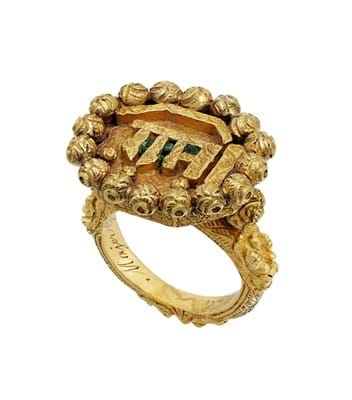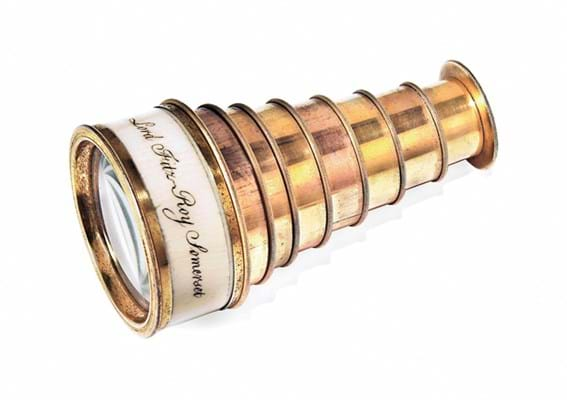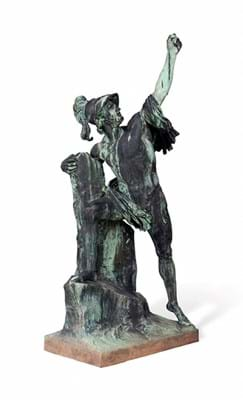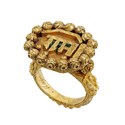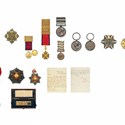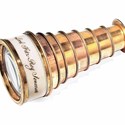The £115,000 paid by a European private buyer against an estimate of £10,000-15,000 at Christie's on May 22 would seem to confirm that it is.
The late 18th century Indian antique gold ring appeared as part of the Raglan Collection and Works of Art from The Collection of the Marquesses of Londonderry.
The stand-out items at the sale, including this one, belonged to the 1st baron, the most prominent member of that family, who was married to the Duke of Wellington's niece, Lady Emily Wellesley-Pole. He served under the Iron Duke in the Peninsula and at Waterloo, losing his arm in the 1815 battle. He commanded British forces in the Crimea, becoming a field marshal in November 1854, but faced criticism following failures of supply, the loss of the Light Brigade and a botched assault on Sebastopol. He died shortly afterwards.
The heavy ring has the name of the Hindu god Rama in raised Devenagri script and the inside of the hoop is engraved Major General Lord FitzRoy Somerset KCB. The key to that price may be that by family tradition it was taken from Tipu, Sultan of Mysore, by Arthur Wellesley, later Duke of Wellington, at the battle of Seringapatam in 1799. He gave the ring to his niece who later became Lady FitzRoy Somerset, and it passed to the Raglan family. Tipu's body was found under the ramparts after the battle.
The two-day sale overall was certainly a mouth-watering prospect: market-fresh material with superb provenance to two of the most influential and prominent British families of the 19th century.
A total of 528 lots were on offer from these historically significant families, linked by their influence in the political world from the Napoleonic Wars onward.
The first day featured the remarkable Raglan items, with the subtitle of Wellington, Waterloo & The Crimea giving an idea of the sweep of the private collection, which came from Cefntilla Court, Monmouthshire, the ancestral home of the Barons Raglan.
Some 312 lots were being sold by order of the executors of Fitzroy John Somerset, 5th Baron Raglan (great-great-grandson of the 1st Baron Raglan). He died in 2010, but a family dispute had blocked an earlier sale.
Many of the items had personal links to the Baron and to Wellington, and some would actually have been used on the battlefield.
A day later, the Marquesses of Londonderry (the Vane-Tempest-Stewarts) were the family in focus, a name synonymous with the art collection they assembled and housed in the palatial Wynyard Park in the North-East and in the now-demolished Londonderry House in Park Lane, Mayfair - a stone's throw from this Christie's sale location, appropriately. The collection of works of art came from those two properties.
The most prominent member of this aristocratic dynasty was Lord Castlereagh, foreign secretary in the later part of the Napoleonic Wars, who played a major role in the peace negotiations such as the Treaty of Vienna which shaped 19th century Europe. The family wealth came when the 3rd Marquess, Castlereagh's half-brother, married fantastically wealthy heiress Frances Vane-Tempest in 1819.
Christie's pre-sale publicity spoke of a combined expectation of £1.5m, but in the event the two days brought a premium-inclusive total of £4,758,500, with 94% sold by lot and 99% by value.
The Londonderry sale day proved to be a particular big hitter, providing £2,738,687 of that overall total and claiming six of the ten top prices, including the two highest sums, despite only offering 216 of the 528 total lots over the two days.
Provenance was obviously a main draw here, along with the historical importance of the items, but the sheer variety on offer attracted a wide range of buyers - indeed, things moved rather slowly simply because of the number of phone and internet bidders competing on so many lots. Despite starting at 1.30pm, the Raglan day alone lasted until 8pm, said Amelia Walker, specialist head of collection sales, the co-head of this two-day sale along with associate director Adrian Hume-Sayer.
She added: "The Raglan saleroom was completely packed; I haven't seen a saleroom that busy for a decorative arts sale. Things like Russian and contemporary arts sales are always packed, obviously, but decorative arts sales buyers tend to be on the phone or online, so to have so many in the room was a real bonus."
International interest came from as far afield as Bangkok, Bermuda and the Bahamas, and Christie's said 29% of the lots were bought or directly underbid on Christie's Live.
"I think, looking round the Raglan saleroom, the majority of bidders and buyers were certainly private," she said. "There were a lot of military enthusiasts, a couple of institutions, a few trade - particularly for more standard pieces like silver. Top lot, the Raglan medal group, was bought by a member of the trade, but there was a lot of private interest both from the UK and abroad, a very interesting mixture of people."
A huge attraction was that both days offered so many different entry points with a something-for-everyone feel: a wide variety of lots were on offer, ranging from militaria, silver and portraits to ceramics and furniture, all boosted by that provenance and historical interest, with a good number of more affordable options underlying those headline prices.
Day two, in particular, had plenty of choice, probably helping to explain its success. The Londonderry side of it had a broader selection of pieces within each category, but still of very high quality.
Ms Walker said: "Certain things such as 19th century sculptures and furniture did very well, and the full-length portraits were an example where the historical importance can go hand in hand with the decorative element and the quality to make the price go completely over our expectations."
Ajax statue soars to top sum
Top lot from the May 22-23 Raglan and Marquesses of Londonderry sale at Christie's came from the Londonderry collection on the second day.
A French monumental bronze sculpture of Ajax bravant les dieux, cast by Charles Crozatier, Paris, from the model by Louis Marie Charles Henry Mercier Dupaty c.1830, defied a £25,000-40,000 estimate to sell for £300,000.
Bought by an advisor, the 9ft (2.75m) high work stood in the garden of Wynyard Park and was provenanced originally to 'almost certainly Charles William Vane, 3rd Marquess of Londonderry'.
It was probably a unique cast by the sculpteur-fondeur Crozatier from the original by Dupaty, first shown in plaster at the 1812 Salon and commissioned for Napoleon.
The plaster was donated in 1883 to the Musée des Beaux-Arts in Bordeaux, where it remains. The Marquess attended a dinner given by King Louis-Philippe at the Palais des Tuileries in May 1837 and it is probable he bought this bronze then.
At the same time he may have bought a lifesize Borghese gladiator also featured in the sale which - like Ajax - sat on a plinth at Wynyard Park.
That 5ft 3in (1.6m) mid 19th century gladiator, catalogued as French or Italian, sold for £60,000 (estimate £15,000-25,000).
Another sculpture high-flier was a French lifesize white marble figure of Suzanne au bain by Pierre Sebastien Guersant, dated 1840, after an original dated 1813 by Pierre-Nicolas Beauvallet.
It was probably commissioned by the 3rd Marquess in 1837 when he and his second wife spent a month in Paris on returning from St Petersburg.
The work is shown in a photograph of the huge sculpture gallery at Wynyard Park c.1890. It more than tripled the top estimate to fetch £130,000 from a European private buyer.
Raglan medals and field marshal's baton
Top-seller from the Raglan day (and third-highest overall) was the group of awards and medals to Lord FitzRoy Somerset, the 1st Baron Raglan (1788-1855), reflecting his long military career ranging from ADC to the Duke of Wellington during the Peninsular War and at Waterloo to commanding the British Army in the Crimea.
Included are the Peninsular Gold medal with clasps for Badajoz and Salamanca and the Peninsular Gold Cross with five clasps. For his first battle the recipient was awarded a gold medal, for his second and third two clasps, and thereafter the gold cross (with clasps). In total, only 165 crosses and clasps were ever awarded.
The lot, comprising 12 awards and medals, also featured the field marshal's baton awarded to Raglan after his victory at Inkerman in the Crimea. Although it sold to the UK trade for just under the low estimate, at £240,000 it was still a considerable sum for medals and reflected the recipient's prominence and remarkable career.
Waterloo telescope
The reason for the still-perfect optics in a George III seven-draw gilt-brass and ivory pocket field glass telescope by Berge, London, late Ramsden, c.1802-10, probably stems from its history. The body is engraved Lord Fitz-Roy Somerset - later 1st Baron Raglan - and it was used by him in the Peninsular War and at Waterloo, where he lost his right arm, meaning that perhaps this telescope was then packed away and never used again, Christie's Amelia Walker suggested. The story behind it may also account for the price of £14,000 on an estimate of £1500-2000.


